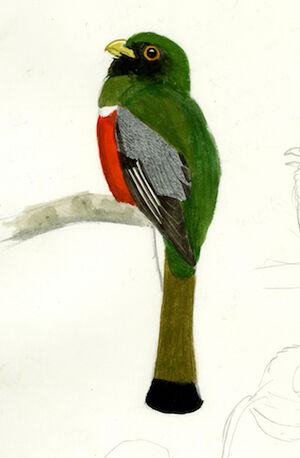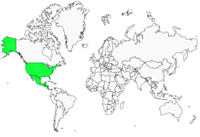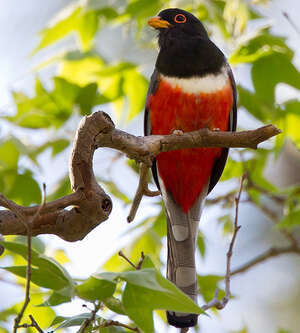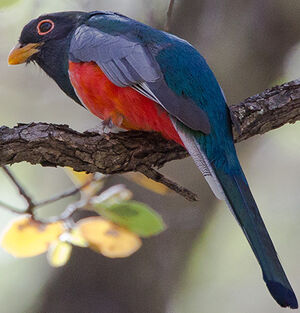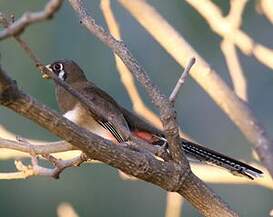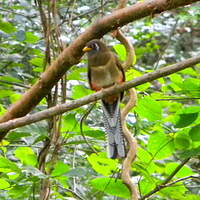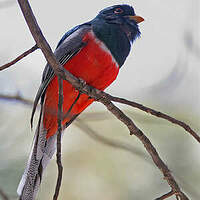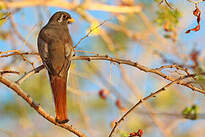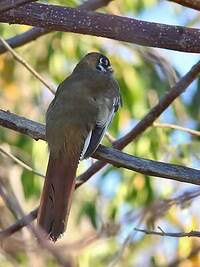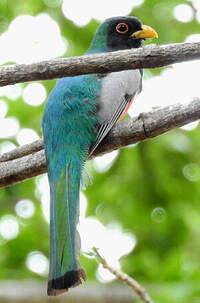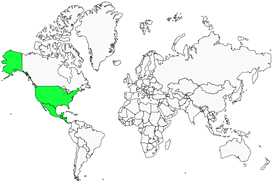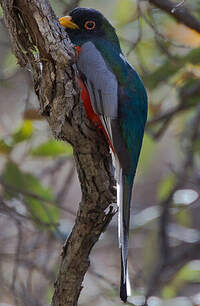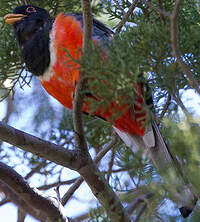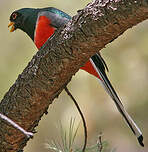Elegant Trogon
Trogon elegans - Trogon élégant
Identification
John Gould, a British ornithologist and artist (1804-1881), chose to baptize this Trogon elegans the Elegant Trogon, perhaps he had this thought after having observed Madame Elegant Trogon. The dimorphism is so pronounced that one can think of having two different birds before one's eyes, so honor to the ladies! Measuring from 28 to 30 cm, the female has a brown cap and forehead with some grey nuances, the beak is yellow, the vibrissae visible, the nape is also brown, the lore is black, in front and behind the eye two very clear white half-circles make up the eye. The dark brown iris is surrounded by an orange-red orbital ring; Madame Elegant Trogon takes care of the detail: a white vertical line descends from the half-circle at the back of the eye to the neck and supreme coquetry, thin black feathers underscore this line, as if someone had made up our subject excessively. The grey throat shows two small white spots on either side of the lower jaw, the upper part of the chest is brown and underscored by a clear white half-moon-shaped mark. The lower part of the chest is chamois, a second, wider white mark is visible to reach the bright pink belly; the female Elegant Trogon thus approaching her cousin, Madame Mountain Trogon, with whom she shares the same distribution area. The mantle and back are of the same brown as the chest, to lighten on the rump and uppertail coverts. The scapulars keep the brown hue of the chest, the small, medium and large coverts are vermiculated light brown and grey, the alula and the primary coverts anthracite contrast with the primary and secondary remiges black with very clear white marginal marks. The tail has three pairs of lower rectrices white horizontally striped with black marks, the first two pairs from the belly have a black mark in the arrowhead center ending in two wide horizontal white spots; the third pair also tinged with white ends with a thick black line.The upper tail feathers are coppery brown and the female may sometimes indulge in vanity by letting the lower white, black and black edged tail feathers show; the end is barred by a thick black line. The male is more "smart" and classic with a yellow beak, parotids, black forehead and throat, surrounding the dark brown eye; the orbital ring stands out in this black background with its orange colour. The cap is dark green almost black, the upper chest emerald green, underlined by an unmistakable white line in contrast with the second part of the chest and belly which are red-vermillion. The mantle and back are emerald green with bronze and turquoise reflections, the scapulae of the same green as the mantle clearly stand out against the large and medium covers finely dotted with horizontal black and white waves the primary covers and the alula are black, the black remiges are, like those of the female, marked by white emarginations. The three pairs of lower white rectrices striped with thin black lines end in increasingly thick white horizontal marks, the tail tip is black. The upper tail feathers are green but of a different shade of green from the back, a green-bronze which changes with the light to turn into a bronze shade reflecting the sun. The tarses are light brown. Juveniles are at least as elegant as their parents: the head is grey with chamois reflections, the yellow orbital ring, which will turn red with age, is girded in white and lengthened by a thick white mark which separates the nape from the throat, the chest is chamois with only one white chamois crescent-shaped bar to reach the cream belly finely striped with white lines. The mantle and back are copper green, the russet suscaudaliae with shining reflections, the small and medium covers are neatly painted with white touches, the large covers are dotted with cream and white and also adorned with white tips, the tertiary and secondary remiges keep the same marbled look while the primaries are anthracite grey with white emarginations.
The upper tail feathers are coppery brown and the female may sometimes indulge in vanity by letting the lower white, black and black edged tail feathers of the Elegant Trogon show; the end is barred by a thick black line. The male is more "smart" and classic with a yellow beak, parotids, black forehead and throat, surrounding the dark brown eye; the orbital ring stands out in this black background with its orange colour. The cap is dark green almost black, the upper chest emerald green, underlined by an unmistakable white line in contrast with the second part of the chest and belly which are red-vermillion. The mantle and back are emerald green with bronze and turquoise reflections, the scapulae of the same green as the mantle clearly stand out against the large and medium covers finely dotted with horizontal black and white waves the primary covers and the alula are black, the black remiges are, like those of the female, marked by white emarginations. The three pairs of lower white rectrices striped with thin black lines end in increasingly thick white horizontal marks, the tail tip is black. The upper tail feathers are green but of a different shade of green from the back, a green-bronze which changes with the light to turn into a bronze shade reflecting the sun. The tarses are light brown. Juveniles are at least as elegant as their parents of the Elegant Trogon: the head is grey with chamois reflections, the yellow orbital ring, which will turn red with age, is girded in white and lengthened by a thick white mark which separates the nape from the throat, the chest is chamois with only one white chamois crescent-shaped bar to reach the cream belly finely striped with white lines. The mantle and back are copper green, the russet suscaudaliae with shining reflections, the small and medium covers are neatly painted with white touches, the large covers are dotted with cream and white and also adorned with white tips, the tertiary and secondary remiges keep the same marbled look while the primaries are anthracite grey with white emarginations.As they age, the tail length increases; the younger the chick, the shorter the tail and it will start to show horizontal black markings, the pattern of which differs depending on the sex and will gradually allow the individual birds to be distinguished. According to experts, four or five subspecies are recognised. The main one is the Elegant Trogon (Trogon elegans) located mainly in Guatemala, which gives its name to its species; then there is the subspecies lubricus, found in Costa Rica and Nicaragua, which has a greater number of black streaks on its lower tail feathers and the female has darker brown colouring; further east, the subspecies ambiguus is found across the central and southern parts of Mexico, with copper and bronze dominating the back and mantle with little or no blue reflection, the male and female lower tail feathers showing a dark and light wiggled pattern and the tail appearing almost white; the subspecies canescens, found in the south of Arizona and New Mexico which have sometimes been elevated to the species level, with a pale red belly, the tail and wings slightly longer than those of elegans and many ornithologists in the United States do not recognise it as a separate species from the elegans; finally, the goldmani subspecies, is only found on the islands of Maria Madre off the west coast of Mexico, the nape and external edges of the chest showing copper and gold reflections and the belly red colour paler than that of elegans, the upper tail feathers more bronze than green and the female much greyer on top and back, the brown and white markings much darker and becoming black and white.
Subspecific information 5 subspecies
- Trogon elegans elegans (Guatemala)
- Trogon elegans canescens (s Arizona. USA. , nw Mexico)
- Trogon elegans ambiguus (s Texas. USA. , e and c Mexico)
- Trogon elegans lubricus (Honduras, Nicaragua and Costa Rica)
- Trogon elegans goldmani (Tres Marías Is.. off w Mexico.)
Foreign names
- Trogon élégant,
- Trogón elegante,
- surucuá-elegante,
- Kupfertrogon,
- elegáns trogon,
- Koperstaarttrogon,
- Trogone elegante,
- kopparstjärtstrogon,
- Fagertrogon,
- trogón pôvabný,
- trogon krásný,
- Pragttrogon,
- kaunotrogoni,
- trogon elegant,
- trogon nadobny,
- elegantais trogons,
- Медный трогон,
- ウツクシキヌバネドリ,
- 优雅美洲咬鹃,
- 銅尾美洲咬鵑,
Voice song and cries
His main call or cry is harsh, Americans qualify it as frog-like plainly it would sing like a frog, a kwa-h, krow-h, ko-ah repeated 4 to 6 times, especially during the breeding season by the male to announce his arrival to other males and warn the females; the cry of the latter resembles a short and high-pitched koink when she answers. His alarm call, in the presence of predators, such as Aphelocoma ultramarina, the Mexican Jay or other trogons is a series of coa-coa-coa that can be repeated 50 times. During the breeding season, the lovebirds launchshort kow or kuh.
Habitat
Probably the most adaptable trogon, from the canyons of Arizona to the slopes of the tropical forests of the North Pacific coast of Costa Rica.
Behaviour character trait
Dietfeeding habits
His opportunism is great, more insectivore than frugivore, he will in fact adapt to his environment and the seasons, more fruit from February to June, which he will gather from acacias, ficus, caesaria; from July to October, all types of insects, orthopterans, hymenopterans, beetles, mantises and larvae, he loves the caterpillars which he cooks by passing them laterally through his beak several times! He will not refuse small reptiles such as lizards.
Reproduction nesting
From May to August in the United States from March to July in Mexico, the Elegant Trogon often has two broods.
Appearantly the sedentary subspecies can have two clutches whereas the nominate migratory elegans from South to North only has one. The courtship of the two adults can be noticed when they raise their tails and puff out the red feathers of their belly, and competition occurs between males and females. The later ones are not the least aggressive, they eventually seize one another and fall to the ground, giving each other violent pecks until blood is drawn. When the pair seems to form, the male goes to investigate the environment to present the best nest to his mate, but she can hear another call and inspect another potential nest presented by another male. The nests are built in large trees like Platanus wrightii, Arizona sycamore, at a height of 8 to 12 meters, in holes at the base of large branches, most of the time in old nests of Picidae like Colaptes auratus, the Flaming Pic or Melanerpes formicivorus, the Acorn Pebbler. The broods are of 2 to 4 eggs and the incubation lasts around 19 days, the pair incubates in alternate and, at hatching, feed the chicks for 12 to 14 days. The young leave the nest after 17 days but stay close to their birthplace for 30 days, where they are still fed by their parents.Geographic range
Two distinct areas: the extreme south of the United States, south of Arizona, including the Cave Creek Canyon Reserve, and New Mexico, sometimes seen in the south of Texas and north of Mexico where ssp canescens and goldmani are found; east, center and south of Mexico, along the gulf of the same name where ssp ambiguus resides. From the south of Mexico to the south of Guatemala, there is a blank, it is absent until reappearing with the nominal species Elegant Trogon, along the Motagua River in Guatemala, El Salvador and Honduras, and finally its southernmost range is in Nicaragua and north of Costa Rica where ssp lubricus resides.
Threats - protection
IUCN conservation status
concern
in the Wild
threatened
evaluated
Birdlife notes an increasing population of the Elegant Trogon, and its vast distribution range and adaptability are currently its greatest strengths. Enthusiasm for this species is high in the United States, where the bird is protected and becoming an icon of the ornithological world, with a Trogon Day usually held in June in Arizona.
Sources of information
- IOC World Bird List (v14.1), Gill, F and D Donsker (Eds). 2024-04-18.
- A Natural history of the Trogonidae, Joseph M.Forshaw Albert Earl Gilbert
- Vol. 6 - Handbook of the Birds of the World, Josep del Hoyo-Andrew Elliott-Jordi Sargatal
- xeno-canto, Sharing bird sounds from around the world,
- Audubon,
- Avibase, Lepage Denis
- Neotropical Birds Online,
- Wikipédia, Wikipedia, The Free Encyclopedia
Other sources of interest
 Specification sheet created on
01/08/2023 by Anne et Gabriel Leboff
Specification sheet created on
01/08/2023 by Anne et Gabriel LeboffTranslation by AI Oiseaux.net
published: 08-08-2013 - Updated: 13-09-2013
© 1996-2024 Oiseaux.net
- Accipitriformes
- Aegotheliformes
- Anseriformes
- Apodiformes
- Apterygiformes
- Bucerotiformes
- Caprimulgiformes
- Cariamiformes
- Casuariiformes
- Charadriiformes
- Ciconiiformes
- Coliiformes
- Columbiformes
- Coraciiformes
- Cuculiformes
- Eurypygiformes
- Falconiformes
- Galliformes
- Gaviiformes
- Gruiformes
- Leptosomiformes
- Mesitornithiformes
- Musophagiformes
- Nyctibiiformes
- Opisthocomiformes
- Otidiformes
- Passeriformes
- Pelecaniformes
- Phaethontiformes
- Phoenicopteriformes
- Piciformes
- Podargiformes
- Podicipediformes
- Procellariiformes
- Psittaciformes
- Pterocliformes
- Rheiformes
- Sphenisciformes
- Steatornithiformes
- Strigiformes
- Struthioniformes
- Suliformes
- Tinamiformes
- Trogoniformes

